Abstract
The regression of lung function change on the initial lung function level is biased when the initial level is measured with random error. Several methods have been proposed to obtain unbiased estimates of regression coefficients in such circumstances. We apply these methods to examine the relationship between lung function loss over 11 years and its initial level in 433 men aged about 20 when first seen. On theoretical and practical grounds the best method is the correction of the regression coefficient using the reliability coefficient. This is defined as the ratio of the error free variance to the variance of the variable measured with error, and is easily estimated as the correlation between repeat measurements of the underlying level. In young men the loss of some lung functions (forced vital capacity [FVC], forced expiratory volume in one second [FEV1], forced expiratory flow in the middle half of expiration, and the ratio FEV1/FVC) do not appear to be related to initial level.
Full text
PDF
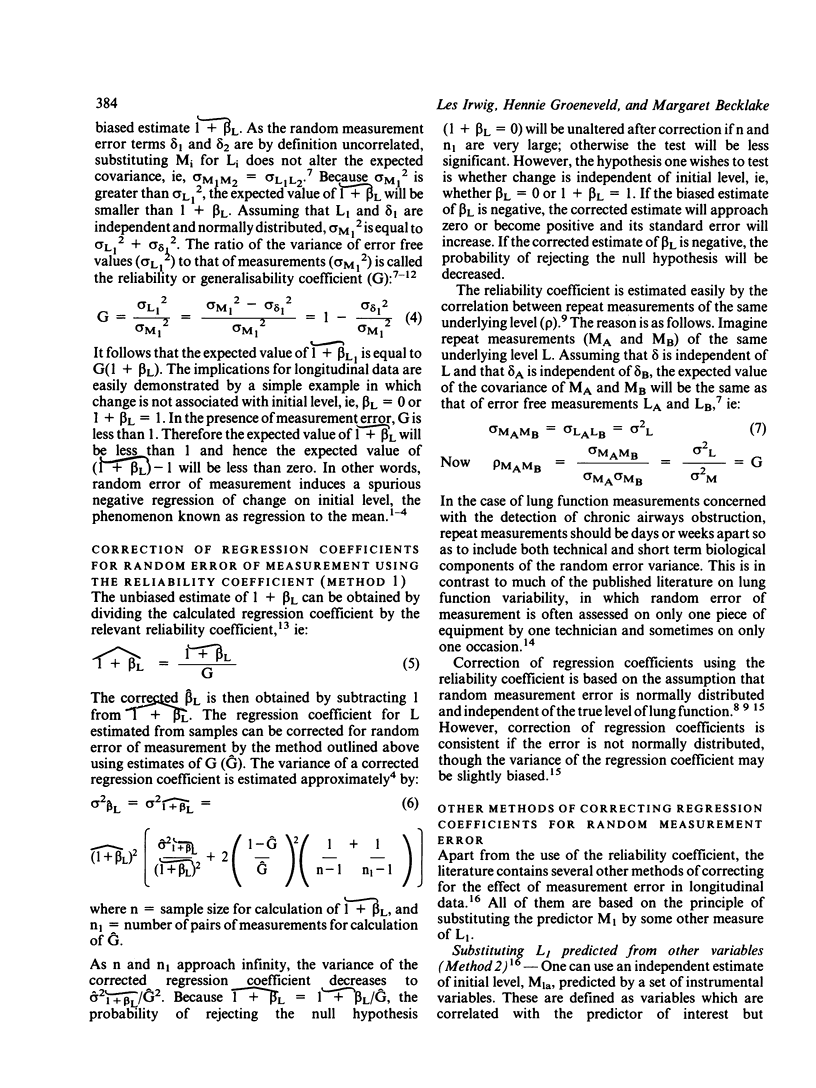
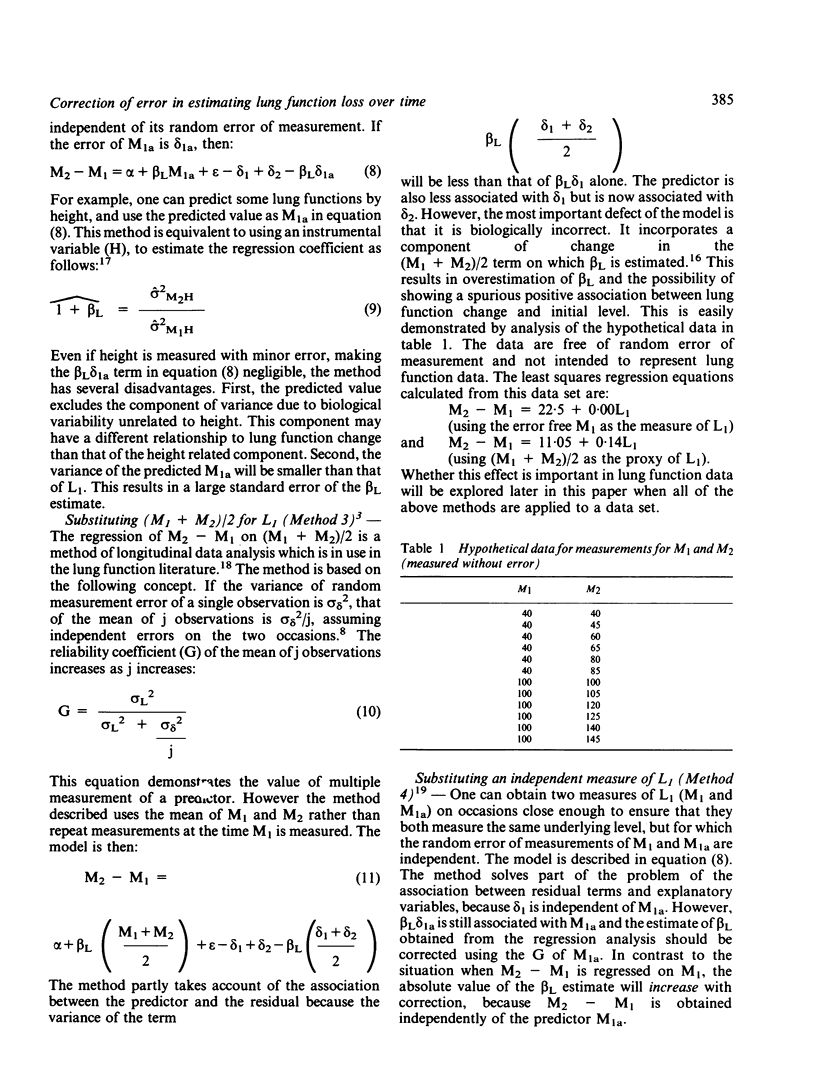
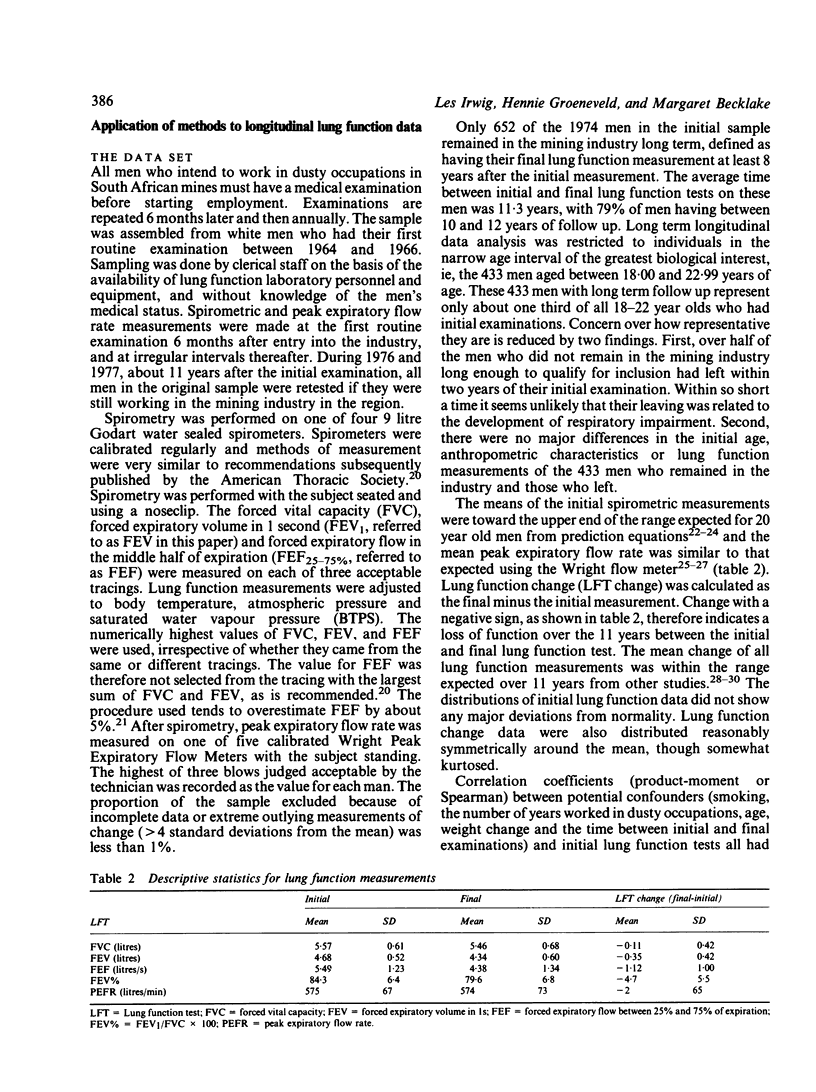
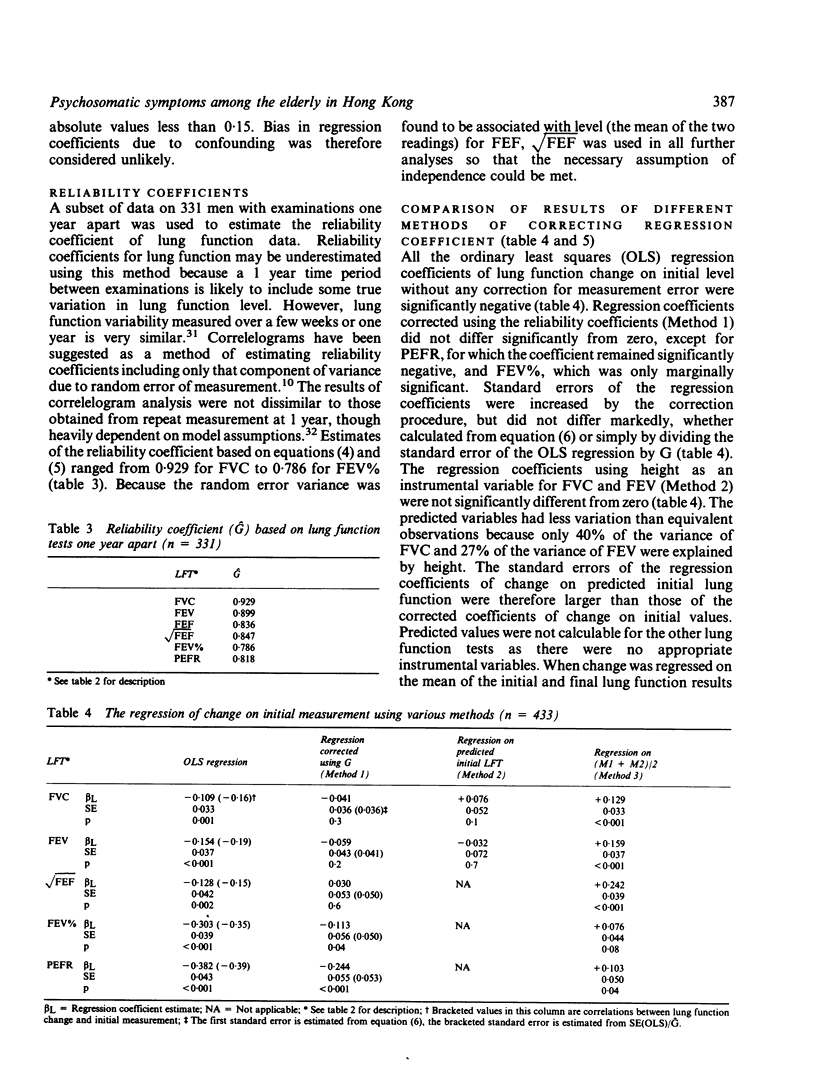
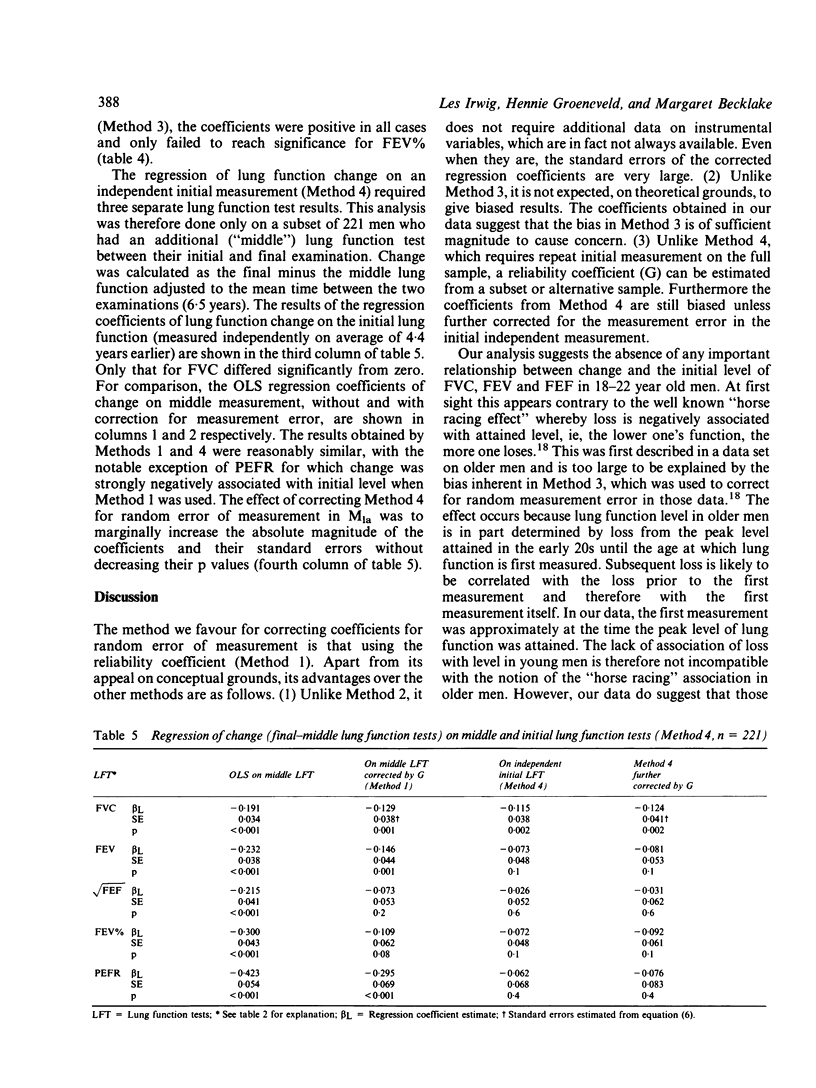
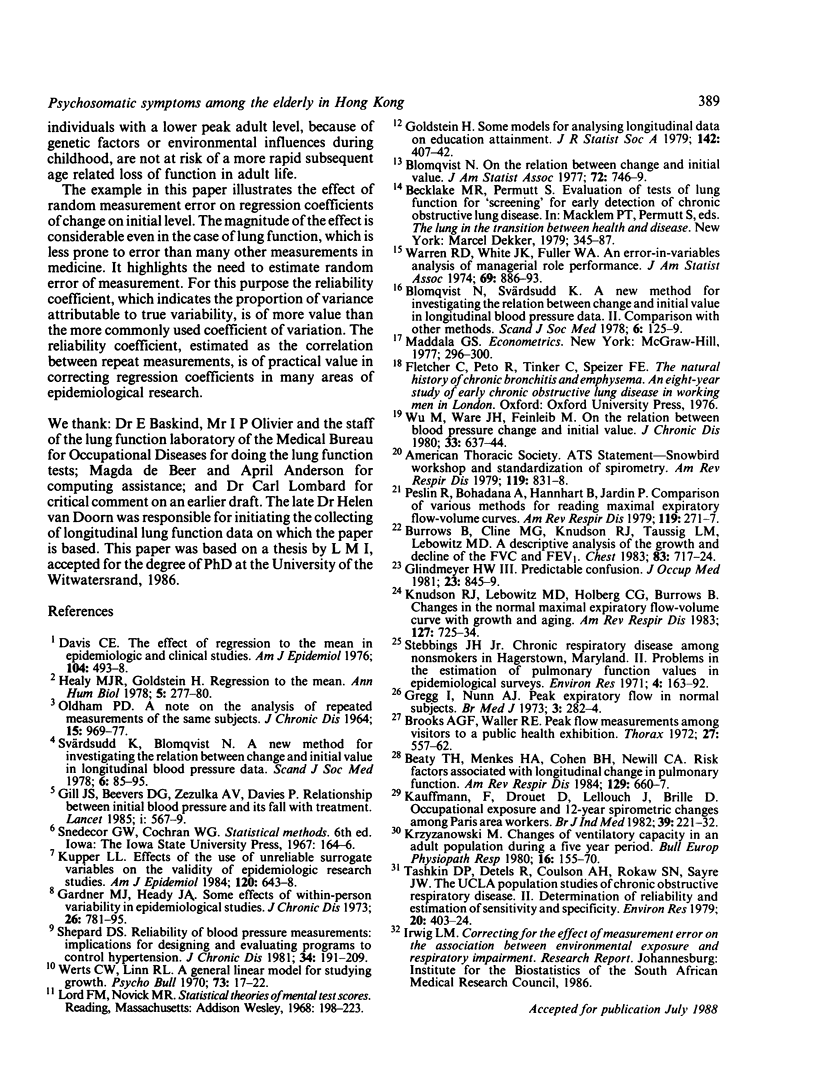
Selected References
These references are in PubMed. This may not be the complete list of references from this article.
- Beaty T. H., Menkes H. A., Cohen B. H., Newill C. A. Risk factors associated with longitudinal change in pulmonary function. Am Rev Respir Dis. 1984 May;129(5):660–667. doi: 10.1164/arrd.1984.129.5.660. [DOI] [PubMed] [Google Scholar]
- Blomqvist N., Svärdsudd K. A new method for investigating the relation between change and initial value in longitudinal blood pressure data. II. Comparison with other methods. Scand J Soc Med. 1978;6(3):125–129. doi: 10.1177/140349487800600305. [DOI] [PubMed] [Google Scholar]
- Brooks A. G., Waller R. E. Peak flow measurements among visitors to a public health exhibition. Thorax. 1972 Sep;27(5):557–562. doi: 10.1136/thx.27.5.557. [DOI] [PMC free article] [PubMed] [Google Scholar]
- Burrows B., Cline M. G., Knudson R. J., Taussig L. M., Lebowitz M. D. A descriptive analysis of the growth and decline of the FVC and FEV1. Chest. 1983 May;83(5):717–724. doi: 10.1378/chest.83.5.717. [DOI] [PubMed] [Google Scholar]
- Davis C. E. The effect of regression to the mean in epidemiologic and clinical studies. Am J Epidemiol. 1976 Nov;104(5):493–498. doi: 10.1093/oxfordjournals.aje.a112321. [DOI] [PubMed] [Google Scholar]
- Gill J. S., Zezulka A. V., Beevers D. G., Davies P. Relation between initial blood pressure and its fall with treatment. Lancet. 1985 Mar 9;1(8428):567–569. doi: 10.1016/s0140-6736(85)91219-x. [DOI] [PubMed] [Google Scholar]
- Gregg I., Nunn A. J. Peak expiratory flow in normal subjects. Br Med J. 1973 Aug 4;3(5874):282–284. doi: 10.1136/bmj.3.5874.282. [DOI] [PMC free article] [PubMed] [Google Scholar]
- Healy M. J., Goldstein H. Regression to the mean. Ann Hum Biol. 1978 May;5(3):277–280. doi: 10.1080/03014467800002891. [DOI] [PubMed] [Google Scholar]
- Kauffmann F., Drouet D., Lellouch J., Brille D. Occupational exposure and 12-year spirometric changes among Paris area workers. Br J Ind Med. 1982 Aug;39(3):221–232. doi: 10.1136/oem.39.3.221. [DOI] [PMC free article] [PubMed] [Google Scholar]
- Knudson R. J., Lebowitz M. D., Holberg C. J., Burrows B. Changes in the normal maximal expiratory flow-volume curve with growth and aging. Am Rev Respir Dis. 1983 Jun;127(6):725–734. doi: 10.1164/arrd.1983.127.6.725. [DOI] [PubMed] [Google Scholar]
- Krzyzanowski M. Changes of ventilatory capacity in an adult population during a five year period. Bull Eur Physiopathol Respir. 1980;16(2):155–170. [PubMed] [Google Scholar]
- Kupper L. L. Effects of the use of unreliable surrogate variables on the validity of epidemiologic research studies. Am J Epidemiol. 1984 Oct;120(4):643–648. doi: 10.1093/oxfordjournals.aje.a113926. [DOI] [PubMed] [Google Scholar]
- OLDHAM P. D. A note on the analysis of repeated measurements of the same subjects. J Chronic Dis. 1962 Oct;15:969–977. doi: 10.1016/0021-9681(62)90116-9. [DOI] [PubMed] [Google Scholar]
- Peslin R., Bohadana A., Hannhart B., Jardin P. Comparison of various methods for reading maximal expiratory flow-volume curves. Am Rev Respir Dis. 1979 Feb;119(2):271–277. doi: 10.1164/arrd.1979.119.2.271. [DOI] [PubMed] [Google Scholar]
- Shepard D. S. Reliability of blood pressure measurements: implications for designing and evaluating programs to control hypertension. J Chronic Dis. 1981;34(5):191–209. doi: 10.1016/0021-9681(81)90064-3. [DOI] [PubMed] [Google Scholar]
- Stebbings J. H., Jr Chronic respiratory disease among nonsmokers in Hagerstown, Maryland. II. Problems in the estimation of pulmonary function values in epidemiological surveys. Environ Res. 1971 Apr;4(2):163–192. doi: 10.1016/0013-9351(71)90044-2. [DOI] [PubMed] [Google Scholar]
- Svärdsudd K., Blomqvist N. A new method for investigating the relation between change and initial value in longitudinal blood pressure data. I. Description and application of the method. Scand J Soc Med. 1978;6(2):85–95. doi: 10.1177/140349487800600207. [DOI] [PubMed] [Google Scholar]
- Tashkin D. P., Detels R., Coulson A. H., Rokaw S. N., Sayre J. W. The UCLA population studies of chronic obstructive respiratory disease. II. Determination of reliability and estimation of sensitivity and specificity. Environ Res. 1979 Dec;20(2):403–424. doi: 10.1016/0013-9351(79)90016-1. [DOI] [PubMed] [Google Scholar]
- Wu M., Ware J. H., Feinleib M. On the relation between blood pressure change and initial value. J Chronic Dis. 1980;33(10):637–644. doi: 10.1016/0021-9681(80)90006-5. [DOI] [PubMed] [Google Scholar]


